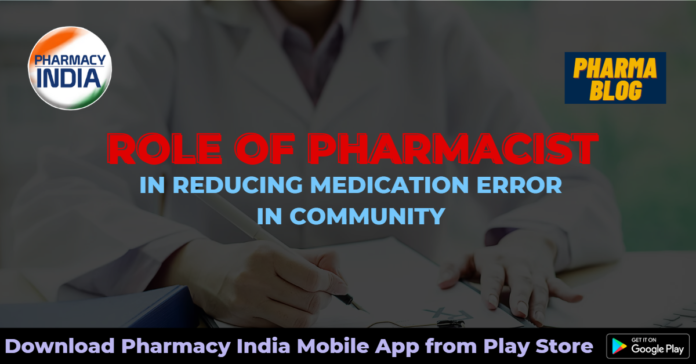What do you mean by Medication?
A medication error is a mistake that happens while taking a medicine, whether it’s being prescribed, dispensed, administered, or monitored. It can occur when a patient receives the incorrect medicine, dose, or route of administration, as well as when a medication is administered at the incorrect time or to the incorrect patient. Medication mistakes may result in harmful medication responses, sickness, injury, or even death. Numerous things, such as human mistake, poor communication, inadequate training, and system-related problems, can lead to them. To stop them from happening again and to guarantee patient safety, it’s critical to report and resolve medication errors.
Medication mistakes could result from a variety of factors, including:
- Human factors: These include issues including weariness, tension, diversion, and a lack of information or experience.
- Communication breakdowns: These can happen between patients, family members, and healthcare professionals. They may include misreading drug instructions, writing that is difficult to see, or failing to convey crucial information.
- Inadequate education or training: Healthcare professionals who are not adequately educated or taught regarding pharmaceutical administration may be more prone to mistakes.
- System-related difficulties: These can relate to electronic health records, automated dispensing equipment, or other technologies, as well as issues with pharmaceutical packaging, labelling, or storage.
- Patient-related factors: These may include things like communication difficulties, cognitive decline, or inconsistent medication use.
- Organisational problems: These may include things like a lack of employees, poor teamwork or communication, or insufficient safety procedures.
To stop medication errors from happening again, it is critical to recognise and address their underlying causes. This may entail modifying policies and procedures, enhancing training and communication, or utilising technology and other resources to increase pharmaceutical safety.
Medication mistakes can take many different forms, including:
- Prescription errors: Prescription mistakes include giving the wrong drug, dose, or mode of administration while writing a prescription for a medication.
- Dispensing errors: Dispensing errors include giving a patient the incorrect drug or dosage, as well as improperly preparing or dispensing a medication.
- Administration errors: When a patient receives the wrong medication or dose of a medication, this is referred to as an administration error.
- Errors in monitoring: These happen when a drug’s effects are not properly tracked, like when it is forgotten to look for adverse effects or drug interactions.
- Documentation errors: These occur when drug-related information is incorrectly recorded or documented, such as when a patient’s chart has the wrong medicine or dose.
- Adherence errors: Errors in medication adherence include missing doses or taking the wrong drug when individuals fail to take their medications as directed
Each kind of medication error has the potential to have detrimental effects on the health and safety of the patient. It is crucial that healthcare professionals take action to stop these mistakes from happening, including putting pharmaceutical safety standards in place, performing routine medication reviews, and enhancing training and communication.
There are many techniques to avoid medicine errors, such as:
- By using computerised prescribing systems, errors related to handwritten prescriptions can be reduced, and the right medication and dosage are prescribed more often.
- Verifying medicine orders twice: To assist lower the chance of errors, healthcare practitioners should confirm medication orders with a different healthcare expert.
- Utilising barcoding technologies: Barcoding can assist guarantee that the right medication is given to the right patient.
- Implementing medication reconciliation: To help ensure that the right drugs are being provided, medication reconciliation entails comparing a patient’s current medications with their medical records.
- Educating the patient: Patients should be informed about their drugs, including the right dosage and how to take them.
- Increasing communication can help decrease drug errors, both with healthcare professionals and with patients. Clear communication of pharmaceutical instructions and patient information can fall under this category.
- Regularly reviewing your medications: Regularly reviewing your medications will help you spot potential mistakes such drug interactions or inappropriate dosages.
- Utilising technology: Automated dispensing systems, for example, can assist lower the risk of medication errors.
- Following safety procedures: Healthcare professionals should follow pharmaceutical safety procedures, such as reading medication labels before giving them out.
Pharmacist play an important role in reducing medication errors: They are experts in medication and are in charge of assuring safe and efficient pharmaceutical use. The following are some steps chemists can take to help reduce drug errors:
- Reviewing prescriptions: Pharmacists can check prescriptions to make sure the right drug and dosage are prescribed.
- Dispensing medications: Pharmacists can make sure that patients receive the appropriate drug and dosage.
- Providing medication councelling: Educating patients on their medications, especially the proper dosage and administration instructions, is something chemists can do for their patients.
- Conducting medication reviews: Pharmacists can evaluate prescription drugs to look for any drug interactions or other concerns.
- Monitoring medication therapy: Pharmacists can keep an eye on a patient’s prescription regimen to make sure the drug is working as intended and isn’t having any negative side effects.
- Working together with medical professionals: Pharmacists can work with medical professionals to make sure that drugs are utilised effectively and safely.
- Implementing medication safety protocols: Pharmacists can help reduce pharmaceutical errors by putting medication safety standards into place, such as double-checking medication orders.
Connect with Us
Click here to follow Us On Instagram
Click here to follow us on Facebook
Click here to follow us on Telegram Channel



